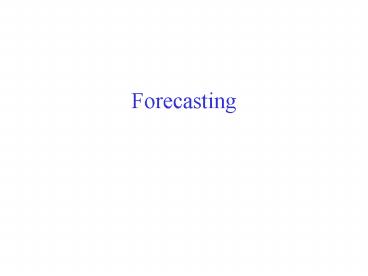Forecasting PowerPoint PPT Presentation
Title: Forecasting
1
Forecasting
2
Forecasting
- Def The process of predicting the values of a
certain quantity, Q, over a certain time horizon,
T, based on past trends and/or a number of
relevant factors. - In the context of OM, the most typically
forecasted quantity is future demand(s), but the
need of forecasting arises also with respect to
other issues, like - equipment and employee availability
- technological forecasts
- economic forecasts (e.g., inflation rates, money
supplies, housing starts, etc.) - The time horizon depends on
- the nature of the forecasted quantity
- the intended use of the forecast
3
Forecasting future demand
- Product/Service demand The pattern of order
arrivals and order quantities evolving over time. - Demand forecasting is based on
- extrapolating to the future past trends observed
in the company sales - understanding the impact of various factors on
the company future sales - market data
- strategic plans of the company
- technology trends
- social/economic/political factors
- environmental factors
- etc
- Rem The longer the forecasting horizon, the more
crucial the impact of the factors listed above.
4
Demand Patterns
- The observed demand is the cumulative result of
- some systematic variation, resulting from the
(previously) identified factors, and - a random component, incorporating all the
remaining unaccounted effects. - (Demand) forecasting tries to
- identify and characterize the expected systematic
variation, as a set of trends - seasonal cyclical patterns related to the
calendar (e.g., holidays, weather) - cyclical patterns related to changes of the
market size, due to, e.g., economics and politics - business patterns related to changes in the
company market share, due to e.g., marketing
activity and competition - product life cycle patterns reflecting changes
to the product life - characterize the variability in the demand
randomness
5
Forecasting Methods
- Qualitative (Subjective) Incorporate factors
like the forecasters intuition, emotions,
personal experience, and value system these
methods include - Jury of executive opinion
- Sales force composites
- Delphi method
- Consumer market surveys
- Quantitative (Objective) Employ one or more
mathematical models that rely on historical data
and/or causal/indicator variables to forecast
demand major methods include - time series methods F(t1) f (D(t),
D(t-1), ) - causal models F(t1) f(X1(t), X2(t), )
6
Selecting a Forecasting Method
- It should be based on the following
considerations - Forecasting horizon (validity of extrapolating
past data) - Availability and quality of data
- Lead Times (time pressures)
- Cost of forecasting (understanding the value of
forecasting accuracy) - Forecasting flexibility (amenability of the model
to revision quite often, a trade-off between
filtering out noise and the ability of the model
to respond to abrupt and/or drastic changes)
7
Applying a Quantitative Forecasting Method
- Determine functional form - Estimate
parameters - Validate
Update Model Parameters
Yes
No

